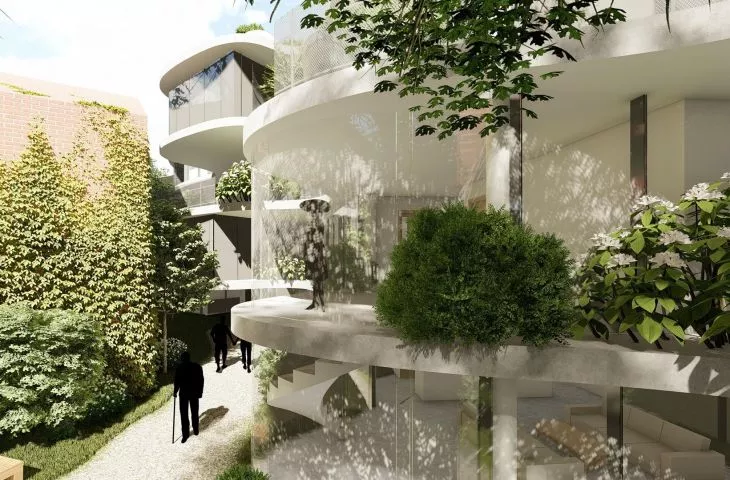Marta Lichaczewska and Joanna Zimna of the Cracow University of Technology have a way to develop a narrow plot of land on Czarnowiejska Street in Cracow. Their design for a green infill attracts attention with its organic shape, the modularity of the apartments and the ubiquitous vegetation that grows even from the railings.
The goal of the assignment performed in the Architeconic and Urban Design Multifamily Residential Architecture class at the Department of Urban Planning and Architecture of Urban Structures A-9 taught by Prof. Mateusz Gyurkovich was to design a residential, multifamily building on a pre-designated plot of land located at 17 Czarnowiejska Street in Krakow.
The task was to design a multi-family building
© Marta Lichaczewska, Joanna Zimna
inspiration by nature
Marta Lichaczewska and Joanna Zimna, working under the guidance of Dr. Damian Poklewski-Koziel, drew inspiration from Japanese architecture, and also looked at the organic shapes of the greenery located in the designed area. The specific shapes of the plot forced the authors to create an elongated building, composed of modules adjusted to provide adequate sunlight to all interiors.
The building consists of residential modules
© Marta Lichaczewska, Joanna Zimna
The shape formed by the presented infill is a consequence of the interpretation of the thick bough and results from numerous analyses of the site and insolation, the authors add.
modular building
The lump of the building is based on columns and is composed of basic rectangular segments and communication, contained in two rounded forms. To the core constructed in this way, the authors added individual modules, containing bedrooms and other rooms, individually tailored to each apartment, allowing to determine its size, use or user preferences. The main segments contain basic functions invariable for each apartment - an entrance area, living room with kitchenette and bathroom. All designed units are adapted to the needs of people with disabilities.
apartment modules and segments
© Marta Lichaczewska, Joanna Zimna
The development of the site involves freeing up the first floor and placing the entire premise on pillars. Thanks to such a solution, a green zone, full of plants and places for recreation and rest, was created on a very small space. On the side of Czarnowiejska Street, the architects designed a public space in the form of a café. Further away is the entrance to the underground garage and a private zone, accessible only to the residents of the designed building.
The development of the area assumes freeing the first floor and placing the whole establishment on pillars
© Marta Lichaczewska, Joanna Zimna
reference to Le Corbusier
The structure was created based on the Dom-Ino model by Le Corbusier. Evenly spaced columns support irregularly shaped ceilings, the overhang of which does not exceed one meter. Additional modules were designed in the form of cantilevers, equipped on two sides with a truss, connecting to the main structure and transferring loads to the columns. The glass facades are enriched in places with an innovative solution in the form of a dark wall, providing privacy.
The retreat of the walls allowed the introduction of terraces and spacious pots in the form of railings
© Marta Lichaczewska, Joanna Zimna
The students decided to move the walls back, thus introducing terraces, which affect less heat buildup in the rooms. Greenery is also an important element. Especially for this project, the authors created pots that serve as railings. In them residents can grow plants and shrubs.
The project as a whole implies a utopian vision of an ecological, green residential ploma, PK students conclude.




















































